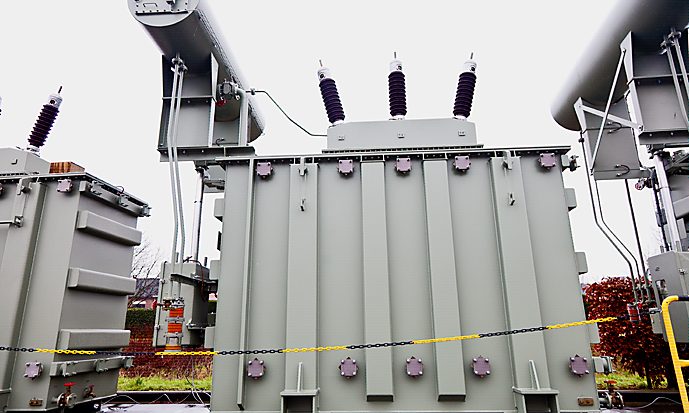Wave of the future
Standing off the Belgian coast is a unique wind farm called Belwind. It lies farther offshore and sits in deeper waters than any other in existence.
Standing off the Belgian coast is a unique wind farm called Belwind. It lies farther offshore and sits in deeper waters than any other in existence.
Case story
.

The offshore substation contains the transformer, the export cable and the grid connection to the coast.
The Belwind onshore and offshore transformers contain about 108 tonnes of oil, equivalent to about 125,000 litres.
In 2011, use of offshore wind power saved 9.8 million tonnes of CO2 emissions. This figure is expected to rise to 102 millions tonnes a year by 2020. The European Wind Energy Association expects the annual investments in offshore wind turbines to rise to EUR 104 billion by 2020.
CG´s Power division develops innovative, highquality, reliable products and turnkey solutions for a wide range of power applications. Their business areas include transformers (distribution and power transformers), switchgear, systems (turnkey projects), automation and services.
Standing off the Belgian coast is a unique wind farm called Belwind. It lies farther offshore and sits in deeper waters than any other in existence.
Offshore wind power generation is a continuously growing energy resource. One of the big players in the offshore wind power game is CG, which is part of the Indian Avantha Group. CG has been in the wind power business for more than a decade, and today half of the existing offshore wind turbines have a CG transformer operating inside of their dynamic frames.
About 46 kilometres from the Belgian port of Zeebruge is one of CG’s partners, a unique offshore wind farm called Belwind. It currently has the distinction of being situated farther from the shoreline than any wind farm in the world. CG contributed to Belwind’s development with two large power transformers, one offshore substation and one onshore booster substation – all critical components required to feed the power generated by the turbines to the network. The 110 wind turbines at Belwind convert enough wind to provide 350,000 households with electrical energy for a year.
The Belwind wind farm’s location is not the only reason it’s unique; it was set up very quickly, too. It took less than a year to design, construct and test. Previous installations have taken up to three years to accomplish these tasks.
“Thanks to Belwind, which was very carefully planned, we got three new offshore wind farm orders late last year,” says Dr Jan Declercq, CG´s Chief Technology Officer.
In the future offshore wind farms will be bigger, located even farther from the shore and in deeper waters. The winds are even stronger farther out to sea, which means the wind turbines will generate more energy. They also won’t disturb fishing and shipping zones.
By the end of 2011 there were 53 offshore wind farms with a total capacity of about 3.8 GW in operation in European waters. Over the past three years, offshore wind energy grew approximately 40 % a year. The forecast offshore wind capacity for 2020 is 40 GW.
“This is a new and growing market, and it will attract a lot of new players,” says Declercq. “But there is a high barrier to enter since offshore wind farms are still extremely cost intensive.”
The European Union takes clean energy seriously, and has mandated its “20-20-20” initiative. By 2020, it plans to cut 20 % of its primary energy consumption and expects 20 % of all energy within the European Union to come from renewable energy. It is estimated that 12 % of the EU’s electricity will come from wind energy by 2020.
“We have a huge job ahead of us to get costs down,” says Declercq. “Today, every project is unique, and the industry is on a steep learning curve. When experience grows and processes reach the next level, costs will come down and electricity generated by offshore wind farms will be cheaper than today. We have to industrialise road transports, project management etc. “CG´s biggest challenge is to develop the technology to make more efficient transformers.”
Even the oil that is used to operate the transformers will probably have to improve in the future to make sure that it will be harmless to the environment should it accidentally leak from the transformer. Today, CG uses several different transformer oils, all of which are produced by Nynas.
“The oil used for offshore transformers is a mineral oil that is very severely refined to obtain an exceptionally high quality,” says Nynas’ Rogier van Hoof. “This is important since the offshore conditions put higher demands on the oil than onshore applications. The transformer oil is not changed and will have a lifetime of more than 30 years.”
With the wind power market continuously evolving, demand for high quality oils will grow along with it, necessitating good relations between oil producers and wind energy organisations.
“That is why we have chosen to work with Nynas,” says Declercq. “We know them well; we have been working together for the past 20 years.”
Nynas has the world's widest range of transformer oils – developed to handle just about every conceivable climate, design and operating condition.
See a selection of our transformer oils based on their key characteristics, including viscosity. For more information on each product, simply download the relevant Product and Safety Data Sheets. See all products